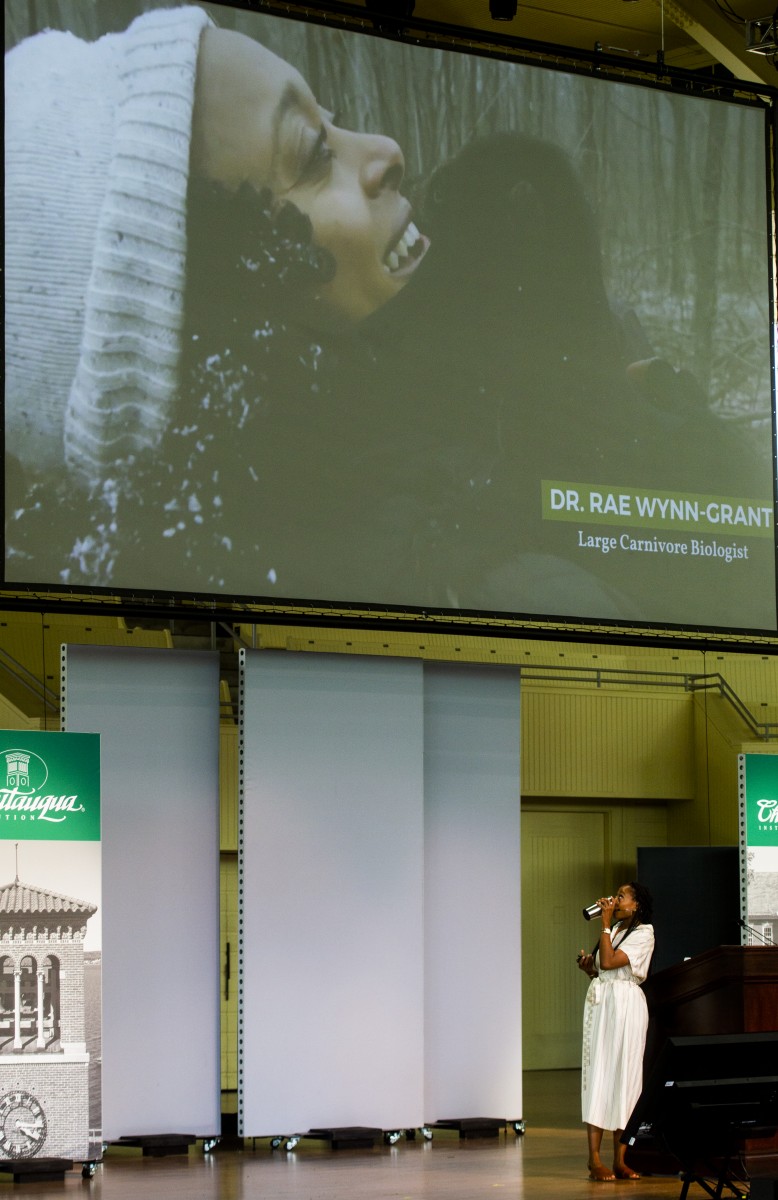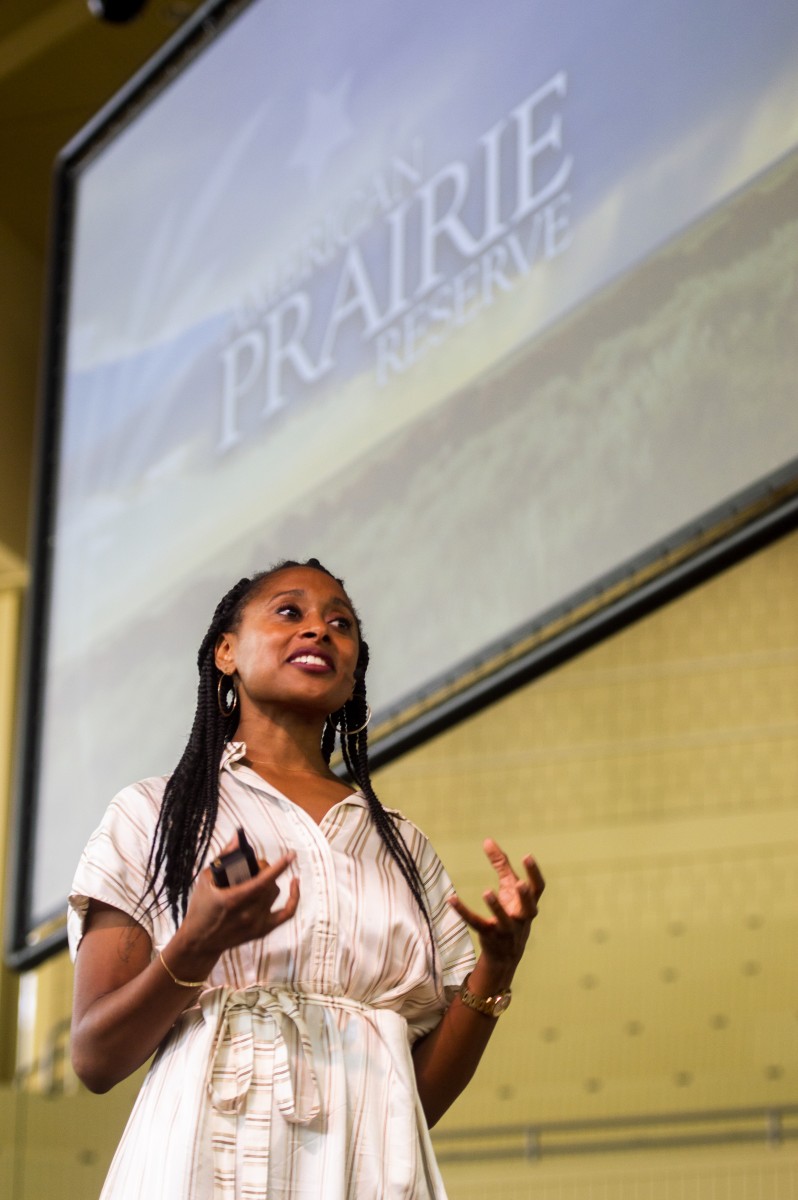Having grown up in cities, Rae Wynn-Grant attributes her career interests in wildlife to the television shows she watched as a child.
Although she steered away from her dreams of hosting a National Geographic nature show, Wynn-Grant still found a way to make a difference for wildlife, particularly in areas where carnivores and people engage one another.
Wynn-Grant, carnivore ecologist and National Geographic fellow, spoke at 10:45 a.m. Wednesday, July 10 in the Amphitheater, continuing Week Three, “A Planet in Balance: A Week in Partnership with National Geographic Society.”
“The interesting thing to me about nature shows was that it was pure entertainment,” Wynn-Grant said. “It was just a joyous experience to watch them. What I didn’t realize was that I was being introduced to science. I was watching science, in action, on the screen.”
Because Wynn-Grant had no first-hand experience in nature, she initially found herself uninterested in her environmental science major. To give it another chance, Wynn-Grant chose the most environmentally based study abroad program her school offered: a semester camping in Kenya.
“There I went from the urban space in Atlanta, all the way to southern Kenya where I was able to pitch my first tent, take my first hike and see my first wild animal,” she said. “That moment, at 20 years old, completely changed my life.”
During her semester abroad, Wynn-Grant was assigned a male lion, the head of a local pride, to follow for the entirety of her stay.
“I learned firsthand its predation patterns, what it eats and where,” she said. “I got to learn how much lions sleep. I got to learn about the different female lions he interacted with, the cubs in the pride, absolutely everything.”
Near the pride’s usual residence was a group of Mossi people, an “iconic” East African tribal group. The Mossi herded cattle, and therefore frequently came into conflict with the wildlife. This created what ecologists call a human-wildland interface, a space where people and animals begin to overlap.
“That was fascinating to me because it wasn’t necessarily a danger zone, but there was a lot of potential for human wildlife conflict there,” she said. “It was in that moment, in East Africa, that I developed my expertise.”
Thinking her career path was set, Wynn-Grant returned to Africa during her graduate program to study female lions. However, her doctorate advisers sent her in a different direction.
In ecology, scientists are supposed to spend an extended period of time studying one animal without any conservation intervention, so studying an endangered species, like lions, was too risky.
Enter the black bear. Wynn-Grant began studying black bears in western Nevada, a state that had only recently accumulated a black bear population.
“There are bears all over the place,” she said. “There are bears probably a few miles from where we are sitting today, but the state of Nevada is very unique in that throughout the history of this continent, there has never been a black bear population (there) until about five or 10 years ago. It’s brand new.”
Climate change brought the bears into Nevada. In its neighboring state of California, there are roughly 40,000 black bears, many of them living in the Sierra Nevada mountain range. During climate-induced drought years when it didn’t snow and the peaks weren’t icy, black bears went over the mountains and started colonizing.
The bears became so abundant in Nevada that a big portion of Wynn-Grant’s work was going into communities, sedating the bears and taking them back into forests.
“Just like working in East Africa with Mossi tribal people, working in Nevada, I was living with very, very local people living off the land,” she said. “There is a tremendous community aspect to doing wildlife ecology there. So often, I was working with homeowners and with police.”
After a few years of working with black bears, Wynn-Grant started tracking female bears using satellite collars. According to her, knowing where a female hibernates is vital because female bears give birth during hibernation.
“These young ladies are not eating anything for about six months, they’re not drinking any water for that time, they recycle their own waste within their body, they don’t urinate or defecate throughout the entire winter and they have to nurse cubs from six inches long into full size cubs that can leave the den and experience the forest,” she said.
Along with measuring the growth of the cubs, tracking the hibernation locations also impacts local development projects.
“There is always a highway to be built or a resort area to be built or a ski lodge to be constructed in the forest,” Wynn-Grant said. “If I am able to advise developers as to where there is important female den-site habitat versus where is not important den-site habitat, we can make decisions about developing landscape that protect people, but also protect sleeping mother bears.”
After 10 years of studying ecology, Wynn-Grant was ready to challenge herself — and National Geographic Society offered an opportunity to study biodiversity in an unexplored rainforest in Madagascar.
Wynn-Grant agreed and was tasked with looking for ring-tailed lemurs, seemingly impossible because the species had only been found in dry places with low elevation and fruit-bearing trees.
But Wynn-Grant was in an area with high elevation, a tropical forest and very few fruit-bearing trees. Somehow, it also had ring-tailed lemurs.
“I realized what I was doing was broadening my science,” she said. “It was tremendous and it resulted in, I’m happy to say, a very high-level scientific discovery because me and my team found a population of ring-tailed lemurs in this tropical rainforest that was unknown to exist to science.”
After five weeks studying ring-tailed lemurs, Wynn-Grant was still struggling to balance ecology and conservation work in a time when “everything was feeling urgent.”
“Studying lions was urgent, studying lemurs was urgent, even studying black bears in the Western United States felt like there was an urgency because there wasn’t enough space for them,” she said.
Wynn-Grant realized she wanted to stop focusing on the extinction crisis and bringing back what isn’t there. Instead, she wanted to work on preserving what already exists. National Geographic Society’s Last Wild Places does just that.
“There are tremendous expanses of land — whether it is grassland, forestland, ocean habitats — that are huge, they are unfragmented, they are intact and they have tremendous promise — that if we keep protecting them starting today, in 50 years, 100 years, 200 years into the future, we’re still going to have them around,” she said. “We won’t be finding an extinction crisis in these places.”
Another National Geographic project is Pristine Seas, which aims to designate protected areas in the ocean.
“Marine protected areas are a beautiful way to set boundaries in the ocean where no one is going to go and make sure the aquatic life is healthy,” she said. “It is an awesome way to ensure the future of our planet’s survival.”
As a fellow with National Geographic Society, Wynn-Grant has partnered with a Last Wild Places project in eastern Montana called the American Prairie Reserve, the largest nature reserve in the continental United States.
Montana is currently populated by more cows than people, but before American farms took over the Great Plains, the grassland was filled with bison, wolves, mountain lions, coyotes and more wildlife. According to Wynn-Grant, those species are now returning.
“All of those wolves, black bears and mountain lions are moving out of Yellowstone and they’re trying to recolonize historic habitat,” she said. “I like to say that they’re coming home.”
The American Prairie Reserve aims to be the biggest and only place in North America, outside of national parks, with healthy populations of all native species. But there’s an obstacle in the way of that goal. The reserve is in a triangle between Glacier and Yellowstone National Parks, and hundreds of cattle ranches are standing in their way.
The danger to the wildlife is not the cows, but the culture that created the ranches they live on. Wynn-Grant said the cattle ranchers’ ancestors were responsible for grizzly bears going extinct in Montana and therefore, they feel it’s a sign of disrespect to them to bring the species back.
“The culture of cattle ranching is not necessarily wildlife-friendly,” Wynn-Grant said. “It’s changing; there are a lot of groups that are changing it and there are a lot of cowboys themselves that are changing that mindset, but historically and traditionally, it’s very anti-wildlife.”
Therefore, the solutions start with open-minded cattle ranchers. Wynn-Grant works one-on-one with ranchers to discuss alternatives that benefit people and wildlife.
For instance, when ranches go up for sale, National Geographic Society will bid on the land. If they win, National Geographic will allow the ranchers to continue living there under certain conditions.
The main condition is that they have to carry out the wildlife-friendly practices provided by National Geographic on a seven-step scale. The scale stipulates: no tilling; allow for an abundance of herbivores on the land, including deer and antelope; use only rain water and natural streams to hydrate the land; don’t disrupt the landscape with things like fencing; don’t harm bears; try not to deter species of conservation concern; and be mindful of ranch size, as the larger a ranch is, the more wildlife-friendly it is.
“National Geographic Society and the Prairie Reserve will pay ranchers depending on what level of the scale they are on,” she said. “They are making money by continuing to have their cattle, along with doing this wildlife-friendly ranching.”
Camera traps capturing mountain lions, bison and other wildlife around the Great Plains prove that the conditions are working. The American Prairie reserve now serves as a model for conservation around the world, and although there are no black bears or lions in sight, Wynn-Grant said America’s prairies are where she’ll continue to be found.
“It has helped me discover my place in this work,” she said. “Instead of the race to end the extinction crisis and reverse it, I found that my place is to preserve those areas that are in the best shape, to protect them, to do lots of long-term studies and to feed the world the science about it moving forward.”










